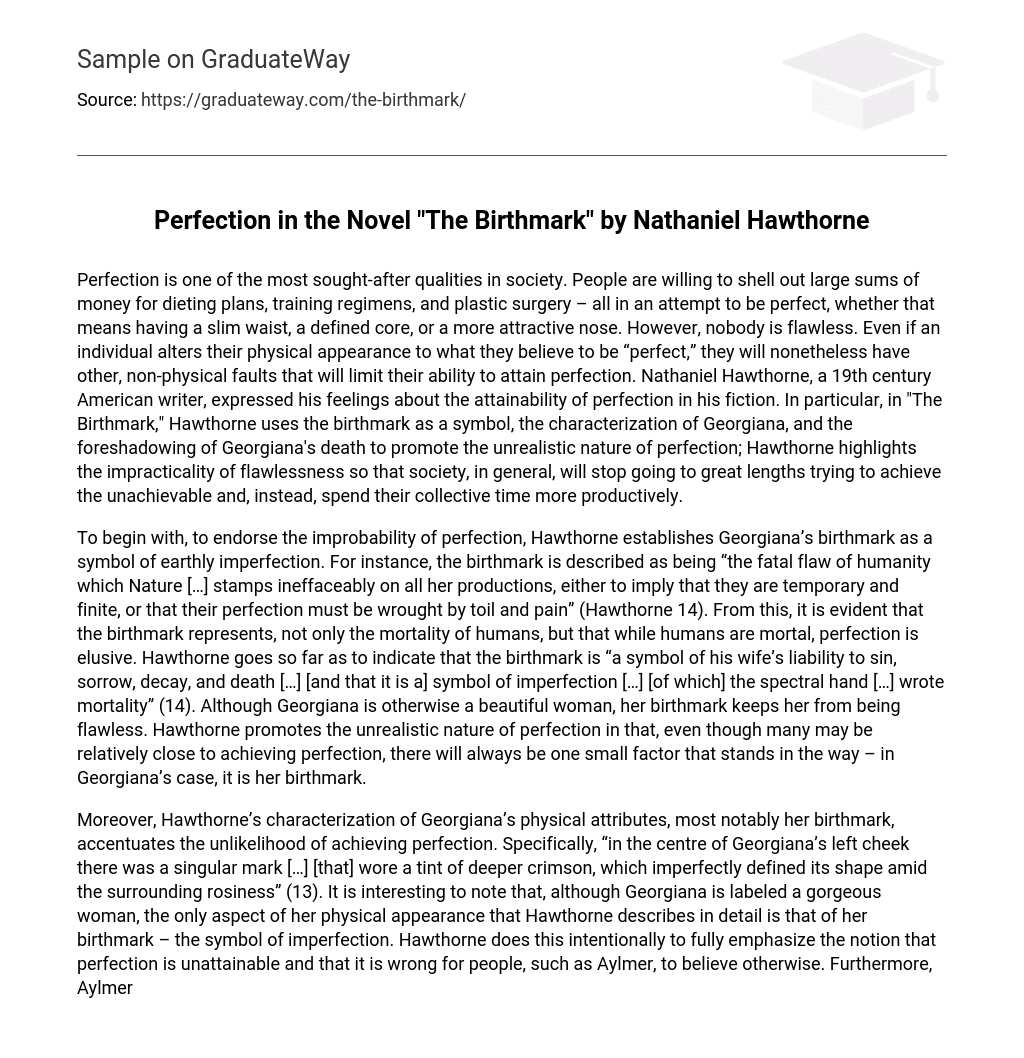Perfection is highly sought after in society, leading people to invest in various methods such as dieting plans, training regimens, and plastic surgery. The goal is to achieve physical perfection, such as a slim waist or an attractive nose. However, no one is without flaws. Even if someone alters their appearance to what they perceive as perfect, they will still possess other non-physical imperfections that hinder their ability to reach true perfection. During the 19th century, American writer Nathaniel Hawthorne conveyed his views on the attainability of perfection through his fictional works. Specifically, in “The Birthmark,” Hawthorne utilizes the birthmark as a symbol, the character Georgiana’s portrayal, and the foreshadowing of her demise to emphasize the unattainable nature of perfection. By highlighting the impracticality of flawlessness, Hawthorne hopes that society will cease its relentless pursuit of the unachievable and instead utilize its time more productively.
To start with, Hawthorne establishes Georgiana’s birthmark as a symbol of earthly imperfection, endorsing the unlikelihood of perfection. According to Hawthorne, the birthmark is Nature’s way of indicating that all creations are either temporary and finite or require toil and pain for perfection. This implies that while humans are mortal, perfection remains elusive. Hawthorne further suggests that the birthmark serves as a symbol of Georgiana’s vulnerability to sin, sorrow, decay, and death, as well as an emblem of imperfection. The spectral hand associated with the birthmark signifies mortality. Despite Georgiana’s overall beauty, her birthmark prevents her from achieving flawlessness. Hawthorne highlights the unattainable nature of perfection by emphasizing that even individuals who come close to achieving it will inevitably be hindered by a small factor – in Georgiana’s case, her birthmark.
In addition, Hawthorne accentuates the unlikelihood of achieving perfection through his characterization of Georgiana’s physical attributes, particularly her birthmark. He specifically describes the birthmark as “a singular mark” on the center of her left cheek, which is slightly darker than the surrounding rosiness (13). It is worth noting that despite being described as a beautiful woman, the birthmark is the only aspect of Georgiana’s appearance that Hawthorne focuses on. This birthmark serves as a symbol of imperfection. Hawthorne intentionally highlights this to emphasize that perfection is unattainable and to challenge Aylmer’s belief in it. Furthermore, Aylmer regards his wife’s birthmark as having a distinct shape that resembles a human hand (13). This connection between the birthmark and mortality reminds us of Georgiana’s humanity and reinforces the idea that achieving perfection is impossible for any human being. Similarly, Hawthorne foreshadows Georgiana’s death to further suggest the unlikelihood of attaining perfection.
In the story, Aylmer dreams of removing Georgiana’s birthmark, which represents imperfection. However, even in his dream, achieving perfection seems difficult. This suggests that in reality, it is almost impossible to attain flawlessness. Additionally, Aylmer asks Georgiana to touch a perfect flower, but as soon as she does, it withers and dies. This event further illustrates the idea that perfection cannot be achieved. Furthermore, when Georgiana reads about Aylmer’s past failures in his experiments, it foreshadows his failure in removing her birthmark. This emphasizes the point that their pursuit of perfection will ultimately lead to disappointment and even death.
In his short story “The Birthmark,” Hawthorne employs the birthmark as a symbol of imperfection to advocate the degree of difficulty associated with achieving perfection. He characterizes Georgiana’s physical attributes and foreshadows her death, in hopes that people will acknowledge the senselessness inherent in trying to be perfect and use their time to accomplish more realistic goals. It is evident that Hawthorne’s outlook on the inability to achieve perfection is sensical. For instance, people around the world invest not only time, but also their hard-earned money, in various products and endeavors that they believe will bring them closer to perfection. Nevertheless, no matter how “close” these individuals get, they will never fully attain perfection. Instead of resorting to plastic surgery, toupees, steroids, or excessive dieting, people would be better off accepting and embracing who they truly are. That acceptance represents the closest anyone will ever come to achieving perfection.





